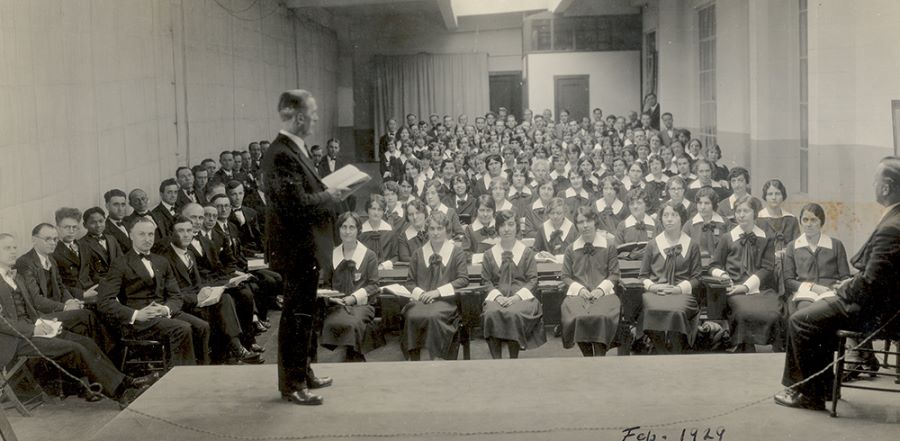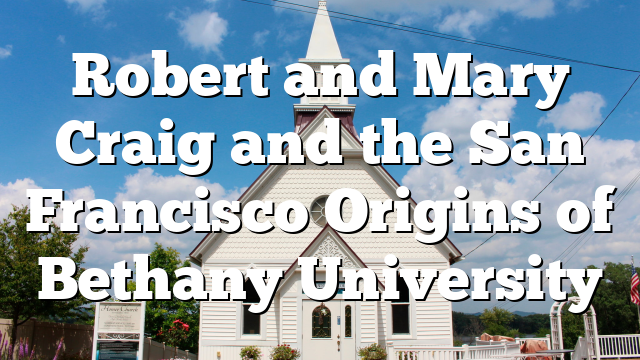Click to join the conversation with over 500,000 Pentecostal believers and scholars
Click to get our FREE MOBILE APP and stay connected
| PentecostalTheology.com




This Week in AG History — March 25, 1951
By Ruthie Edgerly Oberg
Originally published on AG News, 23 March 2023
When it comes to the western half of the United States, Robert (1872-1941) and Mary (1867-1943) Craig were two of the most influential people in the early days of the Assemblies of God. Not only did they serve as founders of the Northern California District Council, but together they built one of the largest churches of their day and started a small Bible class in their kitchen that grew into a university.
Both had been widowed when they married in 1913 – he was 41 and she was 46. Together, they set about pioneering a church in the former Corbett Saloon on O’Farrell Street in San Francisco. Craig had previously pastored a Methodist church before he resigned due to failing health. An experience with the Holy Spirit that healed him of “spiritual impotency” gave him a new lease on life and health and filled him with a passion to see 100,000 souls won to Christ through the sharing of the gospel. Robert and Mary joined the new Assemblies of God fellowship in 1917.
Craig’s marriage to Mary McCulloch proved to be a strong alliance for his evangelistic vision. Recently widowed and financially independent, Mary joined the new mission with passion and zeal for reaching the lost, especially those bound in the addiction of alcohol. When she asked the Lord how the men she was leading to Him would be able to remain steadfast in their faith and sobriety, she felt her instruction was simple: “feed them the Word.” In obedience to the command to “feed them,” she opened up her kitchen in May of 1918 for a new converts class, later saying, “I began Glad Tidings Bible Training Institute with only two students, and one of them was drunk.”
As the church, which came to be known as Glad Tidings Temple, was growing under the leadership of Robert Craig, so was the Bible study under Mary. By Christmas 1918 there were more than 100 students. In 1919, the vision expanded to a two-year structured curriculum as “Pacific Bible and Missionary Training School” (soon changed to “Glad Tidings Bible Training Institute”), focused on providing Pentecostal discipleship, along with preparation for ministerial service. That same year, the Northern California District Council formed with Robert serving as its first superintendent. Mary’s inheritance from her late husband allowed them to serve without taking a salary.
The training institute’s schedule was intentionally designed for immediate application of principles from the classroom through practical ministry experience. The weekday schedule began with prayer before breakfast and classes from 8:45 a.m. to noon. The afternoon was spent working and studying, followed by a 6:45 p.m. class and then evangelistic meetings in the evening where the students took turns leading worship, testifying, preaching, and praying with seekers. Sunday was a highlight of the ministry with a “saint’s meeting” held at 11 a.m., followed by Bible classes at 2 p.m. and a testimony service at 3 p.m. At 6 p.m., the students split into three groups to conduct open-air meetings in different parts of San Francisco while others conducted children’s services at the Temple. All came together at 8 p.m. for the largest evangelistic meeting of the week, when the main auditorium and galleries of the church, which eventually grew to 3,000 people, were packed.
Glad Tidings Bible Training Institute served the Northern California (later Northern California-Nevada) district well, providing training for the majority of their ministers. In 1947, the school came under the direct leadership of the district and in 1950, was moved from the inner-city of San Francisco to the district campground, Bethany Park, in Scotts Valley near Santa Cruz, California. The March 25, 1951, issue of The Pentecostal Evangel reported that “98% of the work” on the new campus was done by people of the district who donated time and labor for their school. During these years, the school acquired accreditation necessitating the enlargement of the library. A call went out to churches and ministers who responded with more than a thousand books, several hundred of which came from J. Narver Gortner’s own personal collection.
With the move to Bethany Park, Glad Tidings Bible Training Institute became Bethany Bible College. When the school became the first in the Assemblies of God to receive dual accreditation as both a Bible school and a liberal arts college, it became Bethany College and later Bethany University. When the school closed in 2011, it had provided training for many Assemblies of God ministers and laity, including a director of Assemblies of God World Missions, a president of the Assemblies of God Theological Seminary, an editor of The Pentecostal Evangel, the head of Convoy of Hope, an editor of Pneuma, several district superintendents, scores of pastors, missionaries, musicians, evangelists, chaplains, teachers, business officials, law enforcement officers, nurses, and many others who widely impacted the Pentecostal movement.
When two widowed middle-aged people fell in love with Jesus, His work, and each other in 1913, they had a vision to see 100,000 souls won through the preaching of the gospel. This vision was brought to fruition over and over again through the ongoing ministry of the students whose training originally began at Mary Craig’s kitchen table.
Read the report, “Glad Tidings, Our Oldest School, Erects New Modern Buildings” on page 13 in the March 25, 1951, issue of the Pentecostal Evangel.
Also featured in this issue:
• “Death Has Been Defeated” by A.T. Pierson
• “How to Seek God” by Walter H. Beuttler
• “God Stirs Hearts in Cuba” by Henry C. Ball
Click here to read this issue now.
Pentecostal Evangel archived editions courtesy of the Flower Pentecostal Heritage Center.Do you have Pentecostal historical materials that should be preserved? Please consider depositing these materials at the Flower Pentecostal Heritage Center (FPHC). The FPHC, located in the Assemblies of God national offices, is the largest Pentecostal archive in the world. We would like to preserve and make your treasures accessible to those who write the history books.
Flower Pentecostal Heritage Center
1445 North Boonville Avenue
Springfield, Missouri 65802 USA
Phone: 417.862.1447 ext. 4400
Toll Free: 877.840.5200
Email: archives@ag.org
Website: www.iFPHC.org


